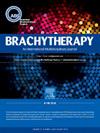Complications of intravascular brachytherapy
IF 1.7
4区 医学
Q4 ONCOLOGY
引用次数: 0
Abstract
INTRODUCTION
There is some evidence of a dose-response relationship for intravascular brachytherapy (IVBT) of native vessel or first-time in-stent restenosis (ISR). It has also been shown that in-field failure predominates following intravascular brachytherapy-treated lesions. Accordingly, it may be advantageous to increase the radiation dose(s) currently used. Given the rationale for escalation from currently doses, a scrutiny of the potential complications that have been reported seems timely.
METHODS
PubMed was searched from 1966 through November 21st, 2023, using the terms coronary and brachytherapy, yielding 1287 references. A 10/16/24 follow-up search of Embase, using the terms “coronary and brachytherapy and complications”, yielding 511 articles. In total, 68 articles were identified as adverse event reports based on their title, or by scrutinizing articles that did not mention adverse events in their titles.
RESULTS
The best documented adverse IVBT-related event is the occurrence of late (> 1 month) thrombosis. Following identification of the risk, longer DAPT regimens were adopted, bringing the incidence to non-IVBT levels. A variety of other adverse events have been reported, including aneurysms, dissections, arterial spasm, “black holes” and vasomotor response inhibition. However, none of which were associated with adverse clinical outcomes.
CONCLUSIONS
Nearly all reports regarding IVBT-related complications are retrospective analyses of a limited number of events, subject to reporting bias. Clinically important IVBT-related complications, at current doses, appear highly unlikely.
血管内近距离放射治疗的并发症。
有一些证据表明,原生血管近距离放射治疗(IVBT)或首次支架内再狭窄(ISR)存在剂量-反应关系。也有研究表明,在血管内近距离治疗病变后,场内失败占主导地位。因此,增加目前使用的辐射剂量可能是有利的。鉴于目前剂量增加的理由,对已报告的潜在并发症进行审查似乎是及时的。方法:PubMed检索自1966年至2023年11月21日,检索词为冠状动脉和近距离放射治疗,共1287篇文献。24年10月16日对Embase进行后续搜索,使用术语“冠状动脉和近距离治疗及并发症”,获得511篇文章。总共有68篇文章根据标题被确定为不良事件报告,或者通过仔细检查标题中没有提到不良事件的文章。结果:记录最充分的不良ivbt相关事件是发生晚期(bb10 - 1个月)血栓形成。在确定风险后,采用更长时间的DAPT方案,使发病率达到非ivbt水平。各种其他不良事件已被报道,包括动脉瘤、夹层、动脉痉挛、“黑洞”和血管舒缩反应抑制。然而,没有一个与不良临床结果相关。结论:几乎所有关于ivbt相关并发症的报道都是对有限事件的回顾性分析,存在报道偏倚。在目前的剂量下,临床上重要的ivbt相关并发症似乎极不可能发生。
本文章由计算机程序翻译,如有差异,请以英文原文为准。
求助全文
约1分钟内获得全文
求助全文
来源期刊

Brachytherapy
医学-核医学
CiteScore
3.40
自引率
21.10%
发文量
119
审稿时长
9.1 weeks
期刊介绍:
Brachytherapy is an international and multidisciplinary journal that publishes original peer-reviewed articles and selected reviews on the techniques and clinical applications of interstitial and intracavitary radiation in the management of cancers. Laboratory and experimental research relevant to clinical practice is also included. Related disciplines include medical physics, medical oncology, and radiation oncology and radiology. Brachytherapy publishes technical advances, original articles, reviews, and point/counterpoint on controversial issues. Original articles that address any aspect of brachytherapy are invited. Letters to the Editor-in-Chief are encouraged.
 求助内容:
求助内容: 应助结果提醒方式:
应助结果提醒方式:


